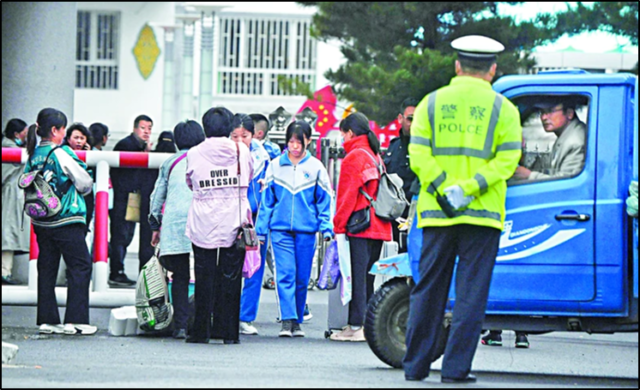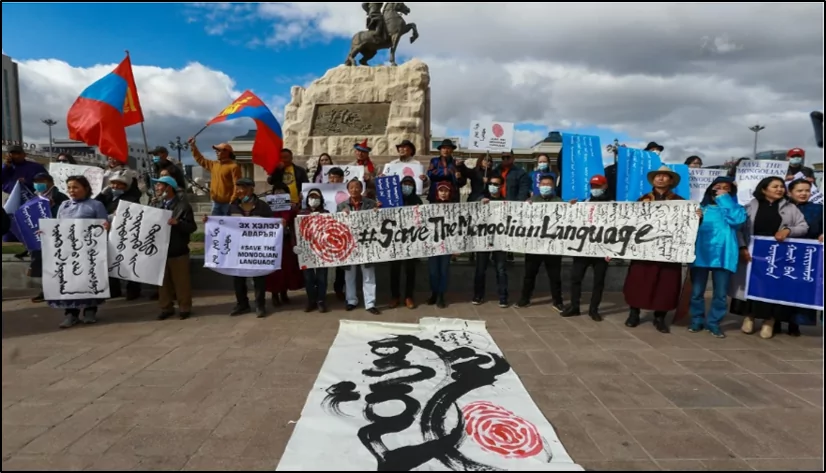
The CCP Extends Its Policies of Forced Ethnic Assimilation to Inner Mongolia
Publication: China Brief Volume: 20 Issue: 17
By:

Introduction
The government of the People’s Republic of China (PRC) has extended its draconian policies regarding the forced assimilation of ethnic minorities into the Inner Mongolian Autonomous Region (内蒙古自治区, Nei Menggu Zizhiqu) (IMAR). From this year’s new school term onwards, students in primary and secondary schools must undergo a “dual language” (双语, shuangyu) policy, under which the status of Mandarin Chinese is emphasized at the expense of the Mongolian language. Henceforth only Mandarin will be used for the subjects of language and literature, history, and politics. This policy change led to street protests—unusual in the normally stable region—in which more than one thousand people were arrested.
Hundreds of parents who refused to send their kids back to school have been detained by police. Some have been fined more than 5,000 yuan ($733 U.S. dollars), while others have been sent to “legal education classes” that resemble the quasi-concentration camps in the Xinjiang Uighur Autonomous Region (Apple Daily, September 16; SCMP, September 13; Human Rights Watch, September 4). Moreover, Chinese Communist Party (CCP) cadres in the region have been given quotas to ensure that a high-enough percentage of children report to schools. The U.S.-based Southern Mongolian Human Rights Information Center claimed that nine people lost their lives during the demonstrations, including an ethnic Mongolian party cadre and a school principal who jumped to their deaths in protest against these policies (Oriental Daily News, September 14; SMHRIC.org, September 4).
Extending Ethnic Assimilation Policies to Inner Mongolia
Methods of coerced assimilation via police-state tactics, which have been used extensively in Xinjiang and Tibet, are now also being enforced in Inner Mongolia. This is despite the fact that the most effective policy of assimilation, gradual Sinicization, has already succeeded in the autonomous region. Only 17.11 percent of the IMAR’s population of 24,706,291 people are ethnic Mongolians. According to the 2010 national census, comparable figures show that 45.84 percent of Xinjiang’s population of 21,815,815 are Uighurs; while 90.48 percent of the Tibet Autonomous Region’s population of 3,002,165 are Tibetans (China Daily, July 17; Asia Dialogue, March 7). Other harsh measures already used include: the imprisonment of political dissidents; closure of anti-Beijing social media chat rooms; and even the collection of DNA from ethnic minority residents (BBC Chinese, August 29; NYT (Chinese edition), June 19).
CCP authorities are apparently also trying to change the lifestyle of Mongolians by discouraging grazing and animal husbandry, and driving the nomads to live in cities. In the summer, the IMAU legislature drafted the Autonomous Region Regulations on Grassland-Livestock Balance and Prohibitions on Herd Cultivation (自治区草畜平衡和禁牧休牧条例, Zizhiqu Cao-Xu Pingheng he Jinmu Xiumu Tiaoli), a set of regulations that would restrict animal husbandry and livestock grazing (Xinhua, August 4; Sohu.com, August 1; Inner Mongolian Daily, August 1). In a press conference, officials of the IMAU cited the party central leadership and CCP General Secretary Xi Jinping as saying that “the ecological conditions of Inner Mongolia is not only tied to the livelihood and development of different nationalities in the IMAU,” and that “the ecological safety of northern China, the northeast, northwest and the whole country will be affected” (Inner Mongolia Government, August 4). These policies parallel similar and ongoing efforts to suppress pastoralist lifestyles in Tibet (China Brief, September 22).

The Hardline Turn Towards a “Second-Generation Policy Toward Nationalities”
The new policy towards Inner Mongolia bears the imprimatur of Xi, who has promoted policies of aggressive and coerced assimilation among the PRC’s 56 ethnic minority groups (China Brief, December 31, 2019). The hawkish supreme leader fears that, as the country’s economy and foreign policy are going through rough patches, the loyalty of China’s ethnic minorities can no longer be reliably counted upon. This is despite the fact that on a visit to the Inner Mongolian city of Chifeng last year, Xi said that Chinese civilization had its roots in multi-racial soil characterized by “being different but harmonious, and [the state of] various types of culture vying for resplendence” (Xinhua, June 9, 2019). However, in another speech on ethnic minority policies last month, Xi said that all nationalities must “firmly cast a consciousness of commonality among the Chinese people” (铸牢中华民族共同体意识, zhulao Zhonghua Renmin gongtongti yishi), so that different ethnic minorities can “tightly embrace each other like pomegranate seeds” (石榴籽一样紧紧抱在一起, shiliuzi yiyang jinjin bao zai yiqi) (People’s Daily, September 10; CCPS.gov.cn, August 29).
The words “consciousness of commonality among the Chinese people” were also used in a meeting of top Inner Mongolian cadres presided over by Bu Xiaolin (布小林), the Chairwoman of the IMAU. “The party leadership with Comrade Xi Jinping as its core highly values the popularization of the nation’s common language,” she said. “The implementation of commonly edited teaching materials [nationwide] manifests the party and nation’s concern for areas with ethnic minorities… [and] is beneficial toward the unity of the nationalities and the development and progress of areas of ethnic minorities” (mp.weixin.qq.com, September 3). Xi recently underscored the role played by education—including teaching materials—in cementing relations among the nationalities. “Education is a major concern for the country and party,” Xi said. “The putting together of teaching materials falls within the state’s jurisdiction.” He added that the central party authorities looked upon “the building up of teaching materials as a fundamental strategic undertaking” (Inner Mongolia Government, August 31; China.com.cn, July 17).
While the PRC constitution guarantees the legal rights of China’s 56 ethnic minorities in the areas of language, culture, religion and economic development, a new corps of conservative CCP theorists has urged the adoption of a “second-generation policy toward nationalities” (第二代民族政策, dierdai minzu zhangce). One prominent theorist on this “melting pot” strategy—meaning “pushing ahead with the integration of nationalities”—is Professor Hu Angang (胡鞍钢) of Tsinghua University, a well-published government adviser. Hu has advocated a change from the first generation of ethnic policy—which allowed different nationalities to keep and develop their own cultures—to a second-generation policy of unity and centralized control. According to Hu, this means “pushing forward the mixing together into one of different nationalities in aspects including politics, economics, culture and society… We must strengthen the Chinese people’s consciousness of identity and uniformity… so as to achieve the great renaissance of the Chinese nation” (Economic Herald, May 7, 2019; Sohu.com, December 17, 2017). “The great renaissance of the Chinese nation” is, of course, a key part of Xi’s most famous slogan, “the Chinese Dream” (中国梦, Zhongguo Meng).
Parallel Policies in Xinjiang and Tibet
There are also clear signs that the CCP is likely to double down on repressive measures on minority nationalities in Tibet and Xinjiang, whose plight has already drawn the attention of leaders and media in the Western world. At a major national conference on Tibet held in late August, Xi again raised the slogan of “casting tight the consciousness of the commonality of the Chinese people.” Xi stated that “We must strengthen the party’s organization and construction of administrative power so as to ensure state security and a long reign and perennial stability.” Without mentioning the recent territorial disputes with India, Xi stressed the strategic importance of peripheral areas: “We must emphasize the strategic idea of giving priority to the administration of border regions in running the country, and giving priority to stabilizing Tibet in administering the border regions.” Citing the imperatives of national unity and the unity of the nationalities, Xi also underscored the imperative of “the Sinicization of China’s religion.” [1] This seems to provide the theoretical underpinning for the increasingly ironclad control by Tibetan police over monasteries in Tibet, owing to Beijing’s perception that monks and nuns are at the forefront of separatism (CGTN.com, August 29; CCPS.gov.cn, August 8).
Meanwhile, the world’s attention has focused even further on the Xinjiang Uighur Autonomous Region (XUAR) following Washington’s passage of a series of sanctions and legislative acts targeting CCP cadres responsible for repressive policies in the vast western region. In mid-September, the PRC State Council published a white paper entitled Employment and Labor Rights in Xinjiang. The document claimed that the party-state authorities “are committed to the people-centered philosophy of development.” The central authorities “attach great importance to job security, give high priority to employment, and pursue a proactive set of policies on employment” (South China Morning Post, September 18; Xinhua, September 17; VOA Chinese, September 17). The CCP authorities’ claims about serving the Uighurs well, however, have been cast into doubt by reports that Han Xinjiang cadres have imposed forced sterilization on members of the ethnic minority (China Brief, July 15).
Conclusion
Beijing’s suppression of Tibetans, Uighurs, and now Inner Mongolians has also been paralleled by the CCP leadership’s increasingly harsh treatment of Hong Kong and Taiwan. The PRC National People’s Congress in June imposed a draconian National Security Law on Hong Kong without going through the legislature of the Special Administrative Region (China Brief, July 29). In recent weeks, the People’s Liberation Army has intensified its war games close to Taiwan, and PLA aircraft have boosted the number of their intrusions into Taiwan’s air space (China.com, September 22; BBC Chinese, September 21). As China’s economy is facing tough times, and China’s global reputation has been hurt by its increasingly aggressive hard-power projection, Xi seems ever-more determined to bolster nationalism and the CCP’s legitimacy by wielding the sword: against ethnic minorities, enclaves not yet under Beijing’s total control such as Hong Kong, and the “runaway province” of Taiwan.
Dr. Willy Wo-Lap Lam is a Senior Fellow at The Jamestown Foundation and a regular contributor to China Brief. He is an Adjunct Professor at the Center for China Studies, the History Department, and the Master’s Program in Global Political Economy at the Chinese University of Hong Kong. He is the author of five books on China, including Chinese Politics in the Era of Xi Jinping (2015). His latest book, The Fight for China’s Future, was released by Routledge Publishing in July 2019.
Notes
[1] Calls for the “Sinicization of religion” (宗教中国化, zongjiao Zhongguohua)—coded language for bringing religious practice under stricter state control—have featured prominently in CCP propaganda and policy in recent years, with Islam, Christianity, and Tibetan Buddhism facing particularly severe pressure (China Brief, April 9, 2019).




